Séverine Sofio
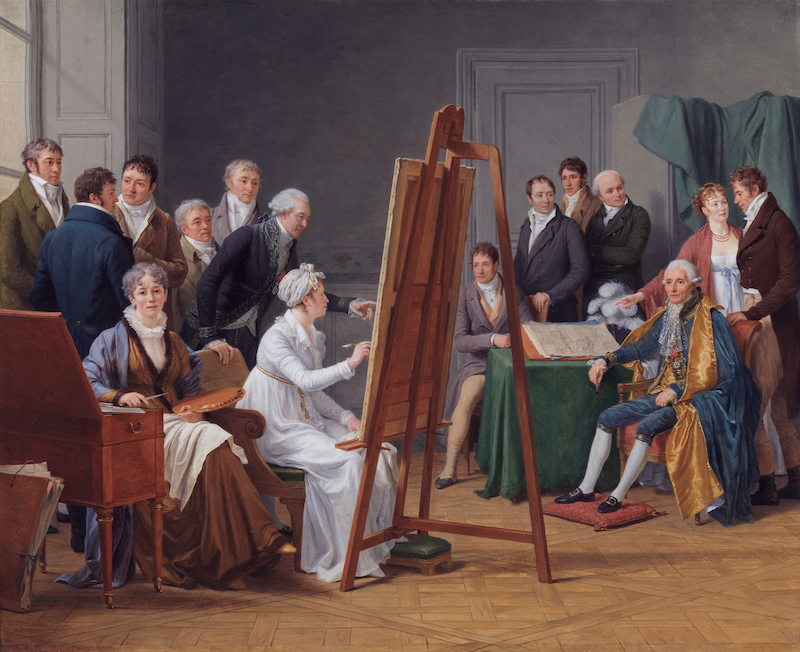
An insignificant self-portrait in a glorious studio scene?
At the Salon of 1808, Gabrielle Capet exhibited a small painting originally entitled Portrait of the Late Madame Vincent (Fig. 1).[1] It is this title, more than the work’s densely populated fifteen-figure composition, which indicates that the painting’s real subject is Adelaide Labille-Guiard, who became “Madame Vincent” after her marriage to François-André Vincent in 1800. Labille-Guiard was Capet’s former teacher and close friend. The two women worked and lived together for more than twenty years, and were undeniably bound by mutual affection and respect, right up until Labille-Guiard succumbed to illness just three years after her marriage.[2]
In this tribute painted five years after Labille-Guiard’s death, Capet showed her friend and teacher in the center of a bright room, dressed in white, seated behind a large easel, absorbed in portraying the venerable sitter at left. This man was the painter Joseph-Marie Vien, posing as if for an official portrait, with all the attributes of his glorious status: the richly-adorned costume of Senator-Count of the Empire, the cross of the Legion of Honor, his feet on a cushion. With porte-crayon in hand and a sketch beside him on the table, he looks to have momentarily suspended work on his own artistic endeavor.[3] This sketch is seemingly the topic of conversation between the young couple standing behind his chair: the elegant young man is Vien’s son (Joseph-Marie Vien fils, also a painter), and the lively red-haired young woman is his daughter-in-law (Rose-Céleste Vien, a specialist in ancient Greek literature).[4] Labille-Guiard’s husband and Vien’s former student, Vincent, is also present in the painting. Standing behind his wife’s chair, leaning forward and smiling, he points to a detail on her canvas. Like Vien, he wears an official costume: the refined uniform of members of the Institut, with its distinctive green embroidery.
Behind the portraitist and her sitter, nine men stand in small groups, creating a warm and friendly atmosphere in the room. They have been identified as painters, all former or current students of Vincent in 1808: on the right, Jacques-Augustin Pajou, Jean Alaux, Etienne and Léon Pallière; on the left, Jean-Joseph Ansiaux, Jean-François-Leonor Mérimée, Charles Thévenin, Charles Meynier and François-Édouard Picot.[5] The quality of each individual portrait was highly praised at the time, reminding the viewer that Gabrielle Capet was an experienced portrait painter, with a career spanning nearly 30 years.[6]
There is one final figure in the room: a woman, seated to Labille-Guiard’s right, casually wearing a blue painter’s smock over her dress, with her elbow resting on an open wooden painting box. In one hand, she holds a knife that she has just been used to load the palette held in her other hand. This is Gabrielle Capet, just as she described herself—“the author […] loading her palette”—in the detailed description of her painting published in the Salon livret.[7] In this self-portrait, curiously placed in the foreground of a composition including the portraits of fourteen other people, Capet pictured herself as a grey-haired woman, with gentle features and a sweet melancholic smile. She is the only figure in the painting who looks directly at the viewer.
Today, this canvas is undoubtedly Capet’s most famous work. Her Portrait of the Late Madame Vincent has been widely reproduced since its rediscovery in the late 1990s, when it was thoroughly studied by the German art historian Thomas Gaehtgens, a leading specialist of Vien.[8] Unsurprisingly considering Gaehtgens’s area of expertise, the canvas was studied first and foremost as a traditional studio scene composed in honor of Vien, his school, and his legacy. However, other aspects of this intriguing composition remain to be considered, not least, the fact that this studio scene was painted by a woman, and, moreover, by a woman who chose to focus the painting on another woman (rather than Vien), while including two more women in the group, among them, herself.
Before further reconsidering the painting with regard to these overlooked facts, it is important to emphasize how singular Capet’s 1808 self-portrait-in-a-studio-scene actually is, both in the context of its author’s career and, more generally, in the history of art. Indeed, her Portrait of the Late Madame Vincent stands as a stark contrast to the rest of Capet’s œuvre: from her beginnings as an artist in 1781, to her last known work in 1818, Capet was primarily a portraitist in miniature and pastel. With one possible exception, she only began painting in oil on canvas from around 1806 (three years after Labille-Guiard’s death).[9] The vast majority of her miniatures and pastels were individual portraits. Thus, the 1808 canvas is not only one of Capet’s first oil paintings, but also her only known multi-figure composition.[10] Furthermore, this unusual painting is itself an anomaly in so far as it is one of the only known self-portraits from this period (possibly the only one?) of a woman painter picturing herself as part of a community of artists. In many ways, therefore, Capet’s 1808 self-portrait-in-a-studio-scene must also be regarded as an exception in the iconographical context of women artists’ self-representations and agency in the late eighteenth-century art world.[11]
It is in light of these exceptional elements that I intend to explore Capet’s complex and multi-faceted Portrait of the Late Madame Vincent. I argue that the painting, in fact, involves several levels of interpretation. I will first demonstrate that, as a tribute to her friend, Capet created a composition that makes many direct references and allusions to Labille-Guiard’s past works. Then, extending Gaehtgens’ analysis of the studio scene as a “genealogy of painters,” I propose a reading of Capet’s work as an aesthetic statement that needs to be placed in the context of cultural politics in post-revolutionary France; namely that, with this painting, Capet expressed her conviction that Vincent’s School was the artistic community most able to defend and perpetuate the academic tradition. Finally, I will highlight how Capet’s self-portrait is the key to both articulating these different levels of interpretation, and to deciphering her subtle and bold message about women’s role in the creative excellence of her time.
Interwoven Paintings: A Tribute to Labille-Guiard’s Works
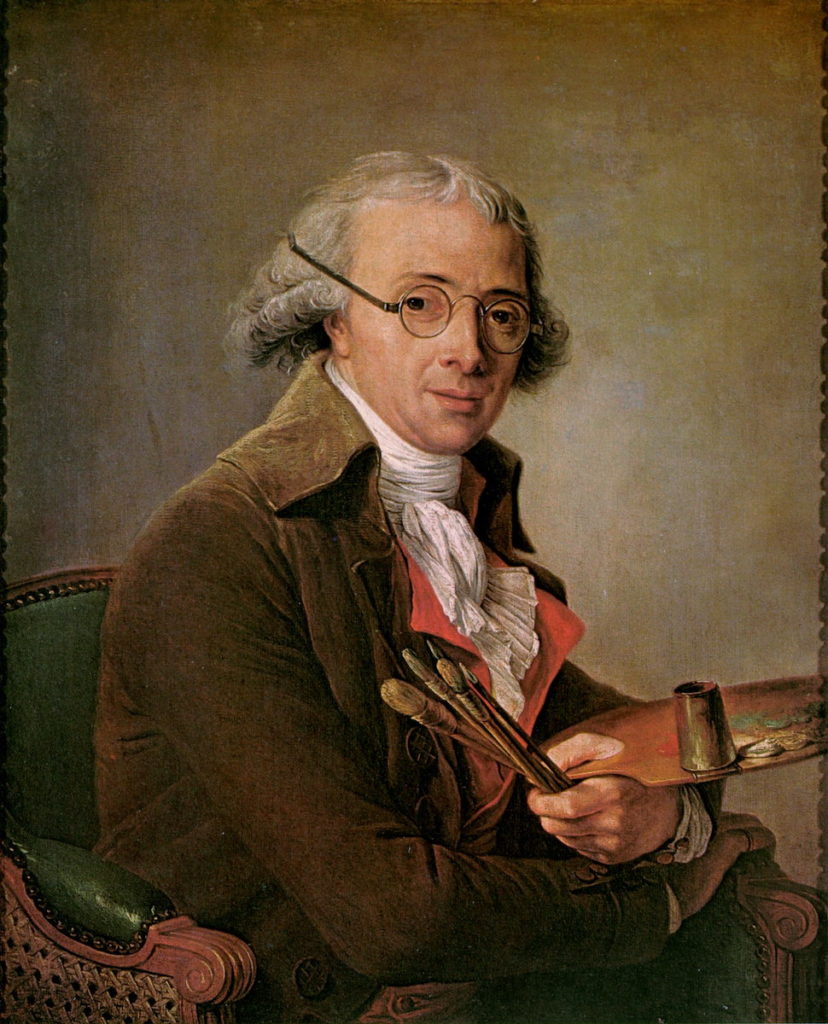
With her simple white dress, her absorbed expression, her face turned three quarters, and her blonde hair loosely tied under a white scarf, the Labille-Guiard depicted in Capet’s painting could not be further from the stylish and triumphant artist that Labille-Guiard represented in her own self-portraits.[12] In fact, in Capet’s 1808 tribute, she chose not to picture the glorious artist who appeared with Capet in the famous portrait of 1785 (discussed below), but a more realistic image of a woman painter at work behind her easel.[13] This posthumous portrait offers a touching image of Labille-Guiard as seen through Capet’s intimate memory of her, informed by their twenty years of living together in the same household.[14] But, more importantly, the 1808 painting is also a composite reminiscence, a delayed echo, of two delightful portraits by Labille-Guiard herself from a few years earlier, in which she pictured her friends—Vincent and Capet—each caught in the midst of their work, in the most intimate atmosphere. Labille-Guiard’s Portrait of the Painter François-André Vincent (Fig. 2) was exhibited at the Salon of 1795; it was her second portrait of him. In the first portrait of Vincent, a pastel from 1783, Labille-Guiard portrayed him formally, as a young and dashing academician; in her second portrait, an oil painting this time, he was affectionately shown as only his close friends might have seen him: working with his glasses on his nose, casually holding his brushes and palette. Three years later, at the Salon of 1798, Labille-Guiard exhibited Citizen Capet Painting a Miniature (Private Collection) (Fig. 3): Capet was pictured seated at her worktable, in a rather austere yet elegant black dress, turning her head from the miniature she was working on, and smiling softly to the viewer. It is one of the last portraits produced by Labille-Guiard, and one of her most touching ones.[15] In fact, one cannot help having it in mind when looking at Capet’s depiction of herself in the 1808 painting: in these two pictures of the same person, Capet’s expression is quite similar. What better way for Capet to honor her friend’s talent as a portraitist, than to represent herself as Labille-Guiard had represented her?
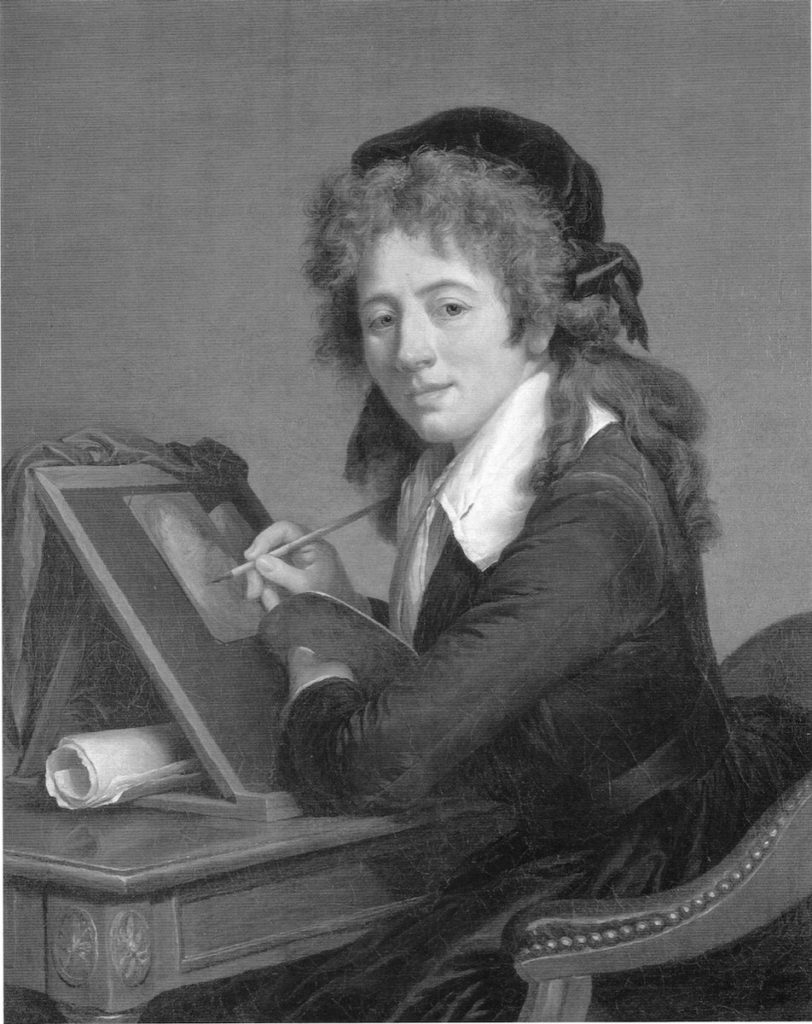
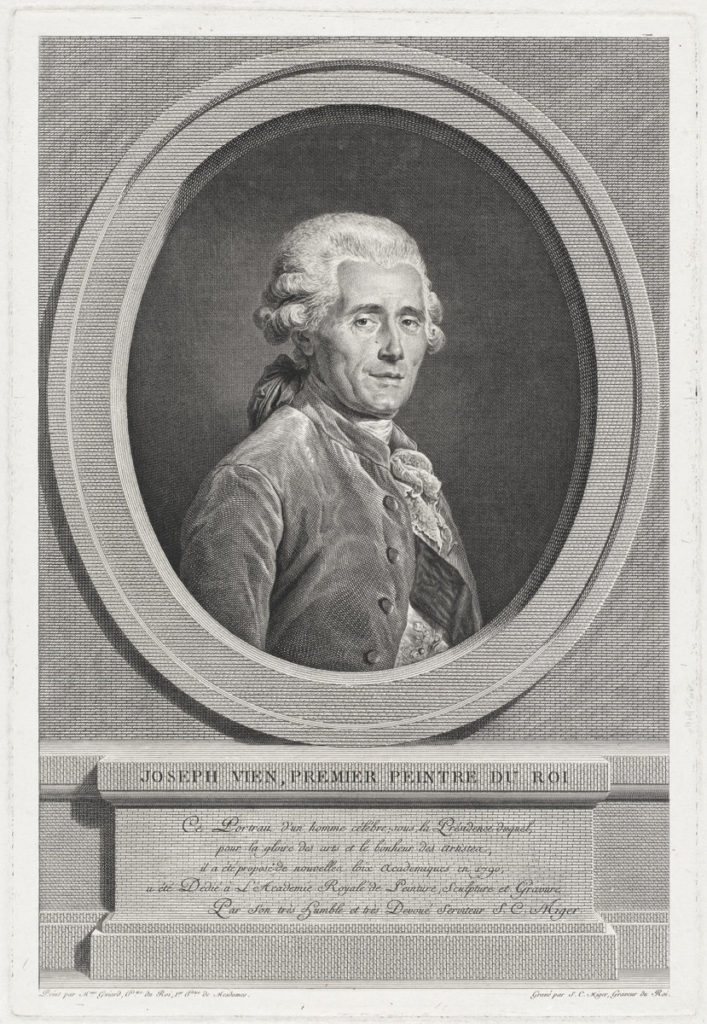
As a matter of fact, in an elaborate and quite playful series of successive mises en abyme, Capet’s group portrait included several other even more direct allusions to her friend’s most famous works. For instance, Capet’s portrait of Joseph Marie Vien in his full regalia is clearly reminiscent of Labille-Guiard’s first Portrait of Vien (Fig. 4), made in pastel when she was a candidate at the Académie at the end of 1782. By then Vien was already a prominent figure in the art world, and his sitting for her was a mark of favor. Her work actually pleased Vien so much that he not only authorized her to have it reproduced in engraving by Simon-Charles Miger, but he also asked her for an oil replica, a significant sign of confidence in Labille-Guiard’s abilities.[16] Her original pastel Portrait of Vien, however, remained in her possession and was still in Vincent’s collection in 1816.[17] Consequently, in 1808, Capet had access to it and it is likely that she used it as a model for her portrait of Vien in her studio scene: here, the “Regenerator of the French School” (as he is named in Capet’s official description of the canvas) rightly appears much older. But, even if 36 years had passed by the time Capet made this new portrait of the venerable painter, the position of his head and his expression still inevitably recall Labille-Guiard’s successful pastel of 1782 (Fig. 5).
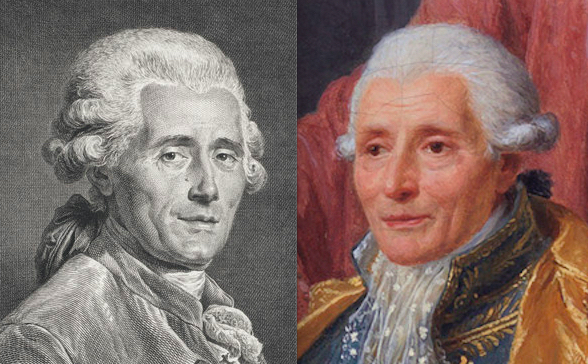
In 1808, another one of Labille-Guiard’s paintings was still in Capet and Vincent’s apartment. Because she never wanted to sell it, Labille-Guiard’s famous 1785 self-portrait actually remained in her possession after its exhibition at the Louvre.[18] This two-meter-high canvas, now known as the Self-Portrait with Two Students (Fig. 6), was originally exhibited at the Salon under a rather opaque title: A Painting (Portrait) of Three Full-length Figures, Representing a Woman Painting and Two Students Looking at Her.[19] We can rightly suppose that it had an important sentimental value for both Labille-Guiard and Capet, since it was at once an undeniable landmark in its author’s career, and an affectionate record of Capet’s training with her teacher. Back in 1785 indeed, in an unusual and powerful artistic gesture to highlight her new status as academician and chef d’école, Labille-Guiard chose to combine the portrait of two of her students with her own triumphant self-portrait: Capet was one of them. In a pyramidal composition, Labille-Guiard pictured her as a lovely smiling young woman, standing behind her teacher, with her hand on the back of Labille-Guiard’s chair. In her 1808 tribute, Capet twice refers openly to this same pyramidal configuration: once, for her rendering of the Vien family on the right, with the old master seated in majesty, his son and daughter-in-law standing behind him and looking at his work; and a second time, for her own “family”—the Vincent-Labille-Guiard-Capet community—on the left.
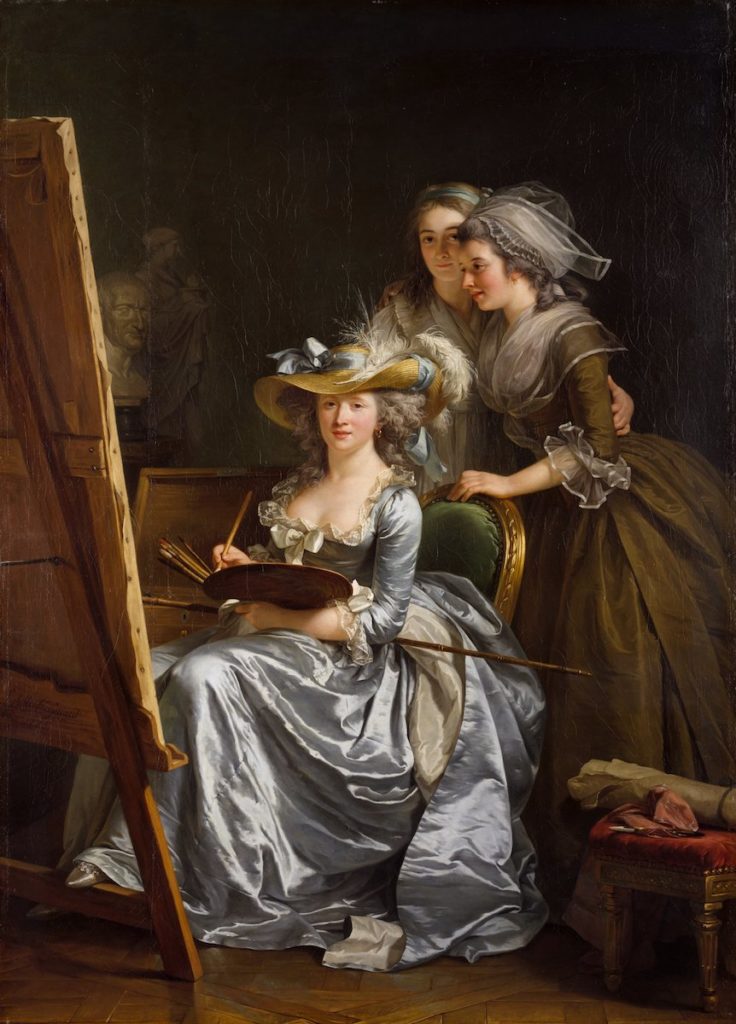
In the 1785 self-portrait, as in the 1808 tribute, Labille-Guiard is seated at her easel, in front of a large canvas of which the viewer can only see the back. But in 1808, the late academician, seen through her former student’s eyes, is no longer depicted as the fashionable, successful artist, but rather, as mentioned earlier, as a woman painter dressed simply and absorbed in her work. Capet’s place in the composition is also changed: in the 1808 picture her pose echoes Labille-Guiard’s. The two women are shown seated side by side, each holding an instrument—one could say an attribute—of the painter’s activity (a porte-crayon for the one, a palette and knife for the other). Here, Capet seems to make a double statement: first, about her status as a professional artist working among her peers (one cannot help but notice that Capet, Labille-Guiard and Vien are the only ones of the fourteen painters present who are in possession of a working instrument); and second, of course, it is an affirmation of her special relationship with her former teacher, who became her colleague and friend. Finally, in a move that is not without humor, Capet chose to place Vincent exactly in the position and attitude that were hers in the 1785 Self-Portrait with Two Students: in the 1808 version of the trio, it is Vincent who is shown with his eyes on the canvas, standing behind Labille-Guiard, smiling, with a hand on the back of her chair. This friendly nod by Capet, which probably did not escape Vincent at the time, could also have been a subtle illustration of their shared history as an elective community of professional artists. With this simple scene (Vincent pointing at Labille-Guiard’s drawing on the canvas, Labille-Guiard listening to him while continuing her work), Capet shows us not only a real partnership based on mutual respect and support between two professionals, but also a dialogue that had been going on since their teenage years.[20]
United by thirty years of uninterrupted communal life[21], the Labille-Guiard-Vincent-Capet collective was at the center of a dense art-world network in which professional relationships were often coupled with family ties. The same is true for the Vien family, of which three members are also present in a pyramidal configuration in Capet’s 1808 tribute. Both groups (the Viens/the Capet-Labille-Guiard-Vincent collective) actually respond to each other in the composition. To emphasize this mirroring effect, Capet used an interesting “play of hands,” involving two pointing index fingers (Vincent’s, on the left, and Rose Céleste Vien’s, on the right) and two hands holding a porte-crayon (Labille-Guiard’s and Vien’s) (Fig. 7). At first glance, Rose-Céleste Vien points to her father-in-law’s Andromache in Tears sketch, while Vincent points to Labille-Guiard’s canvas. Each pointing finger could also be understood to indicate the artist of the other trio—Rose-Céleste Vien pointing to Labille-Guiard, Vincent pointing to Vien—both groups acknowledging each other for posterity, in a courteous and respectful exchange. The hands of Vien and Labille-Guiard, however, tell another story. Both hold a porte-crayon, but Capet chose to picture Vien’s at rest, whereas Labille-Guiard’s is in full activity. Vien’s sketch is visibly done, while Labille-Guiard is just beginning to lay her preliminary drawing on canvas. The silent conversation of these four hands seems to state that, in this great genealogy of painters, creativity has passed from one branch (the Viens) to another (the Capet-Labille-Guiard-Vincent collective).
A School Manifesto in Defense of the Academic Tradition
As Thomas Gaehtgens made clear in his 1999 article, Capet’s painting is a perfect illustration of the notion of (symbolic) family among painters: here is indeed “a genealogy of artists” (“eine gemalte Künstlergenealogie”).[22] Using the iconographical trope of the artist’s studio, Capet composed a multifaceted family portrait that creates and pays homage to a chain of students to teachers (Capet to Labille-Guiard; Labille-Guiard, Pajou, Meynier, Pallière, Picot; Vincent to Vien), which ultimately leads to the true patriarch of this large community: Joseph-Marie Vien. It is important to remember that Vien, at the time, was a tutelary figure for every contemporary French history painter.[23] By choosing to celebrate Labille-Guiard celebrating Vien, Capet certainly proposed a very deliberate tribute-within-a-tribute, honoring both her late friend and the 90-year-old master in one painting. But she also went a step further. In fact, considering the debates that were shaping the art world in the 1800s, Capet’s “genealogy of artists” can also be conceived as a manifesto concerning the pressing question of the future of the French School and the possibility of renewing the academic tradition after the Revolution.[24] If Vien was so unanimously respected in 1808, it was because the painter embodied both the academic tradition of the ancien régime, of which he was a pure product, and the neoclassical aesthetic of the Revolution, of which he was regarded as the precursor. He was therefore perceived, in the post-revolutionary art world, as a universally respected master and a point of agreement on which the fragile unity of the French School was then anchored.[25] But after Vien, who, among his heirs, was to take the symbolic lead? At that time, the most obvious candidates were David and Vincent, and in this competition, Capet’s painting noticeably takes the side of the latter, and should be understood in light of developments that occurred shortly before she made her painting.
From the beginning of their respective careers, David (born in 1748) and Vincent (born in 1746), as Vien’s former students, were seen as competitors: their rivalry, whether real or manufactured by critics, went back to the Salons of the 1780s and took, with the Revolution, a political tint that lasted even under the Empire.[26] In the 1800s, David and his studio were still commonly seen as both Jacobin supporters and rebels against what remained of the academic authority, despite the fact that David’s republicanism was then largely tempered and many of his later students did not share his past opinions.[27] Meanwhile, Vincent and his students had the reputation (well-earned or not, it remains difficult to say) of being largely in favor of monarchy.[28] But above all, both studios were competitors with respect to Vien’s aesthetic and theoretical legacy. Celebrations and public events were therefore organized by one studio or the other to reaffirm their proximity to the teachings of the revered master. In November 1800, for instance, David organized a large banquet in honor of Vien at the Petit Hôtel de Noailles. His famous former students were there: Gros, Girodet, Gérard, etc. After the meal, David raised his glass and declared: “To citizen Vien, our Master, may he, new Diagoras, see the works of his fifth generation shine at the Salons”.[29] Then one of his students read a speech that began as follows, making the purpose of the banquet clear: “Vien was David’s master, David was our master: our glory is David’s, David’s glory is Vien’s.”[30]
Throughout the Consulate and first years of the Empire, David seemed successful in associating his studio with Vien’s legacy, but the situation gradually turned in favor of Vincent who, after Labille-Guiard’s death, ceased to participate to the Salons and devoted his time to his responsibilities as a Professor at the École de l’Institut (the future École des Beaux-Arts) and as a teacher to the young painters in his studio. While David’s ambiguous opinion of academic teaching was well known, Vincent, on pedagogical issues among other things, was far more faithful to Vien’s aesthetic opinions: Vincent gave a lecture on Vien’s views on art in October 1806 at the Institut—a lecture that was immediately printed by Jean-Baptiste Chaussard.[31] It was now clear to the public that the Institut, which had been established a decade earlier to uphold and preserve academic principles and traditions, symbolically endorsed Vincent as Vien’s artistic heir.[32] Moreover this support of Vincent was all the more validated by the fact that, at the same moment, Vincent’s studio emerged as a most efficient incubator for future Prix de Rome. These successive accomplishments of Vincent’s students in the Prix at the end of the 1800s, that is to say Vincent’s proof of success as a chef d’école, were actually clearly emphasized in Capet’s painting. Out of the nine former students of Vincent’s that she chose to portray in the background of her composition, some already had an established career, some were still emerging artists, but all were recognized history painters: three had won the Grand Prix before or during the Revolution,[33] and three would go on to win it after 1808.[34]
Finally, because Capet’s tribute falls within the genre of the studio scene, and because it visibly echoed a certain topicality of the contemporary art world, her canvas has often been compared to another studio scene, shown a few years earlier at the Salon: Boilly’s Isabey’s Studio (1799), which received a great deal of commentary at the time. Indeed, Isabey’s Studio pictured the triumphant “young guard” of painting (among other arts), including painters in all genres, and thus celebrated the hopeful future of a revolutionized French School in all its diversity.[35] As Hannah Williams has shown, Boilly’s horizontal composition symbolized the elective affinities and egalitarianism of this group of artists, in opposition to the strict verticality of traditional academic hierarchies.[36] In that respect, Capet’s 1808 painting was the opposite of Boilly’s, in so far as her representation of history painting’s bright future was based not only on an alliance of all the generations (from Vien to Vincent’s students), but also on a reaffirmed legitimacy of institutional hierarchy and certification (as can be seen, for instance, in the ostentation of Vincent’s or Vien’s official costumes, and in the number of Prix de Rome winners) in the purest academic tradition.[37] From that perspective, Capet’s self-portrait was part of a broader narrative. If she undeniably represented herself as an artist, claiming through her self-portrait, her position as an individual creator, Capet’s identity as an artist also appeared at the same time deeply rooted in the identity of the community formed by her peers. Whether male or female, as Capet revealed in the Portrait of the Late Madame Vincent, the artist is indeed intrinsically and indissociably both singular and collective.
Conclusion: (Self-)portrait of the female artist as the heart of a creative community
The fundamental originality of Gabrielle Capet’s “genealogy of artists” is the fact that this genealogy includes women: not least of all, Capet herself and her own teacher Labille-Guiard. What does it mean that a woman painted such a representation, and, above all, that she chose to picture herself in it?
As we have seen, the painting itself presents several possible levels of interpretation: first, it is a tribute to a recently deceased woman artist and a beloved friend, whose work is a direct inspiration for Capet; second, it honors a tutelary figure of the contemporary French School and the vitality of his legacy, represented by Vincent and his students; but on a third more subtle level, the painting can also be seen as a bold and canny celebration of women’s undeniable but discreet genius, and their rightful place in the larger community of artists. Indeed, for Capet, it seems that Vien’s legacy could be extended beyond his male heirs. Picturing women as members of a prestigious group of artists was quite new: by showing women as legitimate members of a community of artists and by showing a respectful dialogue going on between two professional painters (Labille-Guiard and Vincent), Capet reminds us that, for artists of both sexes, talent is essential, but friendship and support of one’s peers (whether male or female) is also key.
Yet Capet goes even further than that. Returning to Labille-Guiard at the center of the composition, I have already noted that she is pictured at work, behind her easel. However, technically, Capet did not show her friend painting (that is, with brushes and palette in hand). Instead Capet chose to portray her specifically at the beginning of her creative process, during the sketching stage, tracing chalk on the canvas, with her palette still untouched. Clearly, the “painting” itself had not yet started. Was this a way for Capet to express what a tragedy it was for the French School that Labille-Guiard died so young, as if her work as an artist would remain forever unfinished? Possibly. In her own self-portrait, Capet points her red-tipped palette knife towards her friend – a dramatic effect that adds true pathos to the depicted scene.
However, Labille-Guiard is not the only woman in the composition. In fact, Capet placed two other younger women—herself and Rose-Céleste Vien—on either side of her friend, on precisely the same axis. This arrangement is highlighted by the exact alignment of Capet’s red knife and Rose-Céleste’s pointed finger (Fig. 8). As mentioned earlier, Rose-Céleste Vien was then a respected Hellenist and a recognized translator from ancient Greek, who worked extensively with her father-in-law on his last compositions.[38] Through her inclusion in the painting, Capet reminds the 1808 viewer that women also excelled in studies of classical culture and art.[39] Seated in the middle, between a woman painter (Capet herself) and a woman of letters (Rose-Céleste Vien), both embodying women’s rightful place among creators in this time of renewal for the French arts, Labille-Guiard therefore appears as a matriarchal figure, perhaps even, in a way, a female equivalent to Vien.
To end, let us return once again to that play of hands through which Capet illustrated Vien’s legacy. Theoretically and institutionally, Capet made clear that Vien’s heir was Vincent; but concretely, Vien’s praxis—the art-in-progress, the genius-in-the-act as symbolized by the artist’s hand at work—is in fact taken up by Labille-Guiard in the painting: she is the only artist actually working in the painting, she is the one still drawing when Vien’s hand is now inactive. Here is Capet’s discreet and bold tribute to her former teacher: when it came to technique and talent, Vien’s real heir was Labille-Guiard. And Capet, as her proud heir, looking the viewer directly in the eye, portrayed herself handing her friend’s palette.
Séverine Sofio
is chargée de recherche at the Centre nationale de la recherche scientifique in
France
Acknowledgments: I would like to thank both reviewers, as well as Hannah Williams and Melissa Hyde, for their work and constructive comments on this paper.
[1] Tableau représentant feue Mme Vincent (élève de son mari). The canvas, however, is now commonly referred to as Studio Scene or The Atelier of Mme Vincent.
[2] In the second half of the 1770s, Labille-Guiard, then a miniature painter at the Académie de Saint-Luc, who may have already been living separately from her husband (their separation was legally recorded in 1779), decided to take on students, as was common then for professional artists. See Anne-Marie Passez, Adélaïde Labille-Guiard (1749-1803) (Paris: Arts et métiers graphiques, 1973), 15; Neil Jeffares, Dictionary of Pastellists before 1800, http://www.pastellists.com/ (accessed April 3, 2019), entries “Labille-Guiard,” “Capet,” “Carraux de Rosemond.” Marie-Marguerite Carraux de Rosemond and Marie-Gabrielle Capet were among the first of the “nine Muses in the cradle of which [she] was the teacher” [“les neuf muses au berceau dont Madame Guyard est l’institutrice”]—an expression that was popularized by the Journal de Paris, 3 juin 1783 (quoted in Passez, Adélaïde Labille-Guiard, 21). In fact, according to Jean-Pierre Cuzin (in François-André Vincent, 1746-1816, entre Fragonard et David (Paris: Arthena, 2013), 112), Capet attended Labille-Guiard’s studio as early as 1778. Capet and Labille-Guiard lived together in the latter’s successive residences on rue de Grammont, then rue de Richelieu, and briefly in Pontault in 1793-1794. They probably also lived with Carraux de Rosemond until 1788 and with Victoire D’Avril (or Davril), another one of the “nine Muses”, until 1795 (Jeffares, Dictionary of Pastellists, entries “Carraux de Rosemond” and “Davril”). From 1795 to 1802, Capet and Labille-Guiard lived in the Louvre apartment that the Directoire granted the former academician. Vincent had also lived in the Louvre since 1790, but when he married Labille-Guiard in 1800, both kept their respective apartments and the two women still lived together. In March 1802 however, the three painters moved to the Institut. There they lived in two separate apartments, one above the other: Vincent on the first floor, Labille-Guiard and Capet on the second floor, with an inner staircase connecting the two apartments. See Cuzin, François-André Vincent, 257; Passez, Adélaïde Labille-Guiard, 42-43. After Labille-Guiard died in April 1803, Capet stayed with Vincent in the Institut until his death in 1816. This is important because it means that, in 1808, Capet had access to all of her late friend’s past works that had been legally transferred to Vincent as her widower.
[3] The sketch has actually been identified as a replica of Andromaque en pleurs montrant à son fils les armes d’Hector, one of Vien’s last paintings. See Thomas Gaehtgens and Jacques Lugand, Joseph-Marie Vien, peintre du roi, 1716-1809 (Paris: Arthena, 1988), 50 and Thomas Gaehtgens, “Eine gemalte Künstlergenealogie. Zu Marie-Gabrielle Capets Atelierszene in der Münchener Neuen Pinakothek,” Niederdeutsche Beiträge zur Kunstgeschichte, 38 (1999), 210.
[4] Gaehtgens, “Eine gemalte Künstlergenealogie,” 210. On Rose-Céleste Vien, see Gaehtgens and Lugand, Joseph-Marie Vien, 346-347.
[5] Gaehtgens, “Eine gemalte Künstlergenealogie,” 209‑219.
[6] Gaehtgens, “Eine gemalte Künstlergenealogie,” 210-211.
[7] Here is the complete description of the painting that Capet provided for the Salon of 1808: “Portrait of the late Madame Vincent (student of her husband). She is working on a portrait of Senator Vien, Count of the Empire and member of the Institut de France, regenerator of the French School, and teacher of Mr. Vincent. The author, who pictured herself loading her palette, has included Mr. Vincent’s main students in the painting” [“Tableau représentant feue Mme Vincent (élève de son mari). Elle est occupée à faire le portrait de M. le Sénateur Vien, comte de l’Empire et membre de l’institut de France, régénérateur de l’École française actuelle, et maître de M. Vincent. L’auteur qui s’est représenté chargeant sa palette, a placé dans ce tableau les principaux élèves de M. Vincent.”] See the entry for this painting in the online Base Salons 1673-1914, http://salons.musee-orsay.fr/index/notice/23015?offset=1 (accessed October 24, 2019).
[8] After this exhibition in 1808, Capet kept the painting. It was in her “bedroom-cabinet” when she died, and in the inventory of her property, it was by far her most expensive painting (valued 400 F). See “Inventaire après le décès de Mademoiselle Capet (14 nov. 1818),” in Passez, Adélaïde Labille-Guiard, 312-313. The painting remained in private collections until the end of the 20th century, when it entered the collections of Munich’s Neue Pinakothek. It was then the object of Gaehtgens’ 1999 seminal article (see above, note 3).
[9] The first oil painting identified with certainty by Capet is her Portrait of Simon-Charles Miger, signed and dated 1806 (Paris, Bibliothèque nationale de France, Département des estampes et de la photographie). See Marie-Gabrielle Capet, exhib. cat., 87, nr. 32. For this reason, the attribution of the painting in Tokyo’s National Museum of Western Art as an earlier self-portrait by Capet seems doubtful (indeed, the work does not appear in Capet’s recent exhibition catalogue, mentioned in note 10).
[10] No painting with more than two figures in it is mentioned in Arnauld Doria’s catalogue raisonné of her work—Gabrielle Capet (Paris: Les Beaux-arts, 1934)—or in Marie-Gabrielle Capet (1761-1818), une virtuose de la miniature. exhib. cat. (Gand; Caen: Snoeck; Musée des beaux-arts de Caen, 2014).
[11] For an overview of the questions raised by the study of women’s self-representation in art history, see Melissa Hyde, “‘Peinte par elle-même?’ Women artists, teachers and students from Anguissola to Haudebourt-Lescot,” Arts et Savoirs, 6 (2016), https://journals.openedition.org/aes/794 (accessed October 24, 2019).
[12] At least three of them are known today: a miniature portrait (Celle, Germany, Foundation Miniaturensammlung Tansey), which is one of Labille-Guiard’s earliest known works and was exhibited at the Salon de l’Académie de Saint-Luc in 1774 (she was 25 years old); a self-portrait in pastel (current location unknown) which was exhibited in 1782 at the Salon de la Correspondance, and is reproduced in Jeffares, Dictionary of Pastellists, entry “Labille-Guiard”, 4, J.44.101/102 and in Laura Auricchio, Adélaïde Labille-Guiard: An Artist in an Age of Revolution (Los Angeles: Getty Publications, 2009), 24, fig. 16; and the well-known 1785 oil portrait with two students from the Metropolitan Museum in New York, which will be discussed later in the article. Also, Capet herself had already portrayed Labille-Guiard at least once, around 1790, in a miniature (reproduced in Marie-Gabrielle Capet, exhib.cat., 77, fig. A), which was in a Swiss collection before being sold by Sotheby’s in 2018: http://www.sothebys.com/fr/auctions/ecatalogue/2018/pohl-stroher-collection-l18322/lot.115.html (accessed October 24, 2019).
[13] With the only oddity being the white dress, a rather inappropriate color to wear when working with paint.
[14] As a consequence of her long communal life with Labille-Guiard and then with Vincent, Capet’s whole career and posterity stayed somewhat in the shadow of her more famous friends. Even in the only exhibition ever devoted to her work, in 2014, Capet is described as “an artist under influence.” Xavier Salmon, “Marie-Gabrielle Capet pastelliste, une artiste sous influence”, in Marie-Gabrielle Capet (1761-1818), exhib. cat., 27-35.
[15] In that, I disagree with Laura Auricchio who considers it as “a reduced vision of Capet’s accomplishments.” Auricchio, Adélaïde Labille-Guiard, 106.
[16] Passez, Adélaïde Labille-Guiard, 104-107.
[17] The pastel was bought by Vien’s son for 38 Francs (quite inexpensive for this kind of work, according to Neil Jeffares) after Vincent’s death in 1816. Jeffares, Dictionary of Pastellists, “Labille-Guiard,” 2.
[18] The painting was indeed included in the inventory of goods transferred to Vincent after Labille-Guiard’s death. Passez, Adélaïde Labille-Guiard, 308. See also, on Madame Adélaïde’s failed attempt to buy Labille-Guiard’s 1785 self-portrait, as a testimony of the artist’s will to keep it: Melissa Hyde, “Under the Sign of Minerva: Adélaïde Labille-Guiard’s Portrait of Madame Adélaïde”, in Melissa Hyde and Jennifer Milam, eds., Women, Art and the Politics of Identity in Eighteenth-Century Europe (London, New York: Routledge, 2003), 139-163.
[19] Un Tableau (Portrait) de trois Figures en pied, représentant une Femme occupée à peindre & deux Élèves la regardant. Interestingly enough, neither Labille-Guiard’s 1785 nor Capet’s 1808 self-portraits were named as such in their original title.
[20] Joachim Lebreton, who was Labille-Guiard’s friend and first biographer, described Vincent as her “childhood friend” [“l’ami de son enfance”]. Joachim Lebreton, Notice nécrologique sur Madame Vincent née Labille (Paris: Impr. de Chaignieau, an XI, 2). The Vincent and Labille families were indeed neighbors on rue Neuve des Petits Champs in Paris in the 1760s. Élie Vincent (André’s father) was a protestant miniature painter and a professor at the Académie de Saint-Luc. Adélaïde Labille became his student in 1763 and remained close to the Vincents in the following years. For instance, once a certified master at the Académie de Saint-Luc, Labille-Guiard rented her first independent studio to Suzanne Griois, Vincent’s sister (Passez, Adélaïde Labille-Guiard, 19). Similarly, one of Marguerite Carraux de Rosemond’s legal subguardians was Vincent, when the young woman lived on rue de Richelieu with Labille-Guiard, then her teacher, and Capet (Jeffares, Dictionary of Pastellists, “Carraux de Rosemond”, 1). But Labille-Guiard and Vincent became particularly close after his return from Rome in 1775: from that year on, they kept on attending the same professional and social circles. Elizabeth Mansfield (The Perfect Foil: François-André Vincent and the Revolution in French Painting (Minneapolis: University of Minnesota Press, 2012), 124-129) even showed that during the 1780s, the two painters regularly worked together, exchanging models, ideas and accessories that can be found in their respective paintings. Moreover, Vincent’s influence on Labille-Guiard’s work during that period has been analyzed: Cuzin demonstrated for example that the immense canvas (4.50m x 5.50m) depicting La réception par le comte de Provence d’un chevalier de Saint-Lazare, a commission received by Labille-Guiard in 1788, had been a “joint work” with Vincent, produced over two and a half years (Cuzin, François-André Vincent, 257). It would thus seem logical to suppose that Labille-Guiard may have had a similarly creative impact on some of Vincent’s works, an idea which has so far been seldom contemplated.
[21] See above, note 2, and Passez, Adélaïde Labille-Guiard, 280.
[22] Gaehtgens, “Eine gemalte Künstlergenealogie,” 209‑219.
[23] Gaehtgens and Lugand, Joseph-Marie Vien, 49-50.
[24] On the situation of the French art world in the 1800s, see for example Annie Becq “Expositions, peintres et critiques: vers l’image moderne de l’artiste,” Dix-huitième siècle 14 (1982), 131-149.
[25] Gaehtgens and Lugand, Joseph-Marie Vien, 116.
[26] Hannah Williams, Académie Royale: A History in Portraits (Farnham & Burlington: Ashgate, 2015), 284; Mansfield, The perfect foil, 10‑12. As strange as it may seem today (with David’s posterity being so clearly above Vincent’s in art history), the competition between both artists was crucial in the art world in the 1800s. Jean-Pierre Cuzin considers that Vincent’s posthumous career was actually marked by a series of bad choices and unlucky events (Cuzin, “Les malchances de Vincent,” François-André Vincent, 9-11).
[27] On perceptions of David’s studio, see Philippe Bordes, “Jacques-Louis David et ses élèves : les stratégies de l’atelier,” Perspective, 1 (2014), 99‑112.
[28] The belief that Vincent and his students were mostly reactionary was apparently based on rumors spread by David’s students themselves. Isabelle Mayer-Michalon, Charles Meynier, 1763-1832 (Paris: Arthena, 2008), 103. Strangely enough, this reputation is perpetuated today. For instance, it has been claimed that the Vincent-Labille-Guiard-Capet collective remained “intimately royalist” during the revolutionary period, without any factual evidence to support this statement (Marie-Gabrielle Capet, exhib. cat., 16).
[29] Gaehtgens and Lugand, Joseph-Marie Vien, 47.
[30] However, in his speech at Vien’s funeral in 1809, David actually praised less the content of Vien’s teaching than his support in moments of discouragement, which is consistent with his denigration of the teaching methods at the Académie royale more generally. Gaehtgens and Lugand, Joseph-Marie Vien, 47, 116.
[31] “Des idées générales sur la peinture et sur les arts d’imitation,” Magasin encyclopédique. Journal des sciences, des lettres et des arts, VI (1806), 150.
[32] Gaehtgens and Lugand, Joseph-Marie Vien, 116.
[33] Mérimée and Meynier were Second Grand Prix winners in 1787 and 1789 respectively; Thévenin was awarded the Prix in 1791; both Pajou and Ansiaux narrowly missed it.
[34] Pallière was awarded the prize in 1812, Picot in 1813 and Alaux in 1815.
[35] Annie Scottez-De Wambrechies, Louis Léopold Boilly, 1761-1845 (Paris, Lille: N. Chaudun, Palais des beaux-arts de Lille, 2011), 142-143.
[36] Williams, Academie Royale, 302-303.
[37] Capet’s position in this painting is, in fact, far from being a minority among the female artists of her time. Indeed, if we consider the specific context of the French art world between the 1780s and the 1810s, it seems entirely coherent for women painters to have defended an academic tradition that advocated training in private studios (several of which were open to women at that time), or respect for the basic principles of the hierarchy of genres and subjects. At that time, far more women were actually practicing history painting than flower or landscape painting. See Séverine Sofio, Artistes Femmes. La parenthèse enchantée, 18e-19e siècles (Paris: CNRS Editions, 2016), 96 ff.
[38] Gaehtgens and Lugand, Joseph-Marie Vien, 110.
[39] It is important to recall, for instance, that the presence and achievements of women painters at the Salon of 1806, which was the last one before Capet exhibited her tribute to Labille-Guiard, were indeed particularly, and most favorably, commented on in the contemporary press. Henriette Lorimier’s Jeanne de Navarre in particular was distinguished by the critics and considered one of the best history paintings of the Salon that year. Lorimier, a former student of Jean-Baptiste Regnault, received a first-class medal, and her canvas (now at the Musée national du château de Malmaison, in Rueil-Malmaison) was bought by Empress Joséphine. See Sofio, Artistes Femmes, 242-243.
Cite this article as: Séverine Sofio, “Gabrielle Capet’s Collective Self-Portrait: Women and Artistic Legacy in Post-Revolutionary France,” Journal18 Issue 8 Self/Portrait (Fall 2019), https://www.journal18.org/4397.
Licence: CC BY-NC
Journal18 is published under a Creative Commons CC BY-NC International 4.0 license. Use of any content published in Journal18 must be for non-commercial purposes and appropriate credit must be given to the author of the content. Details for appropriate citation appear above.

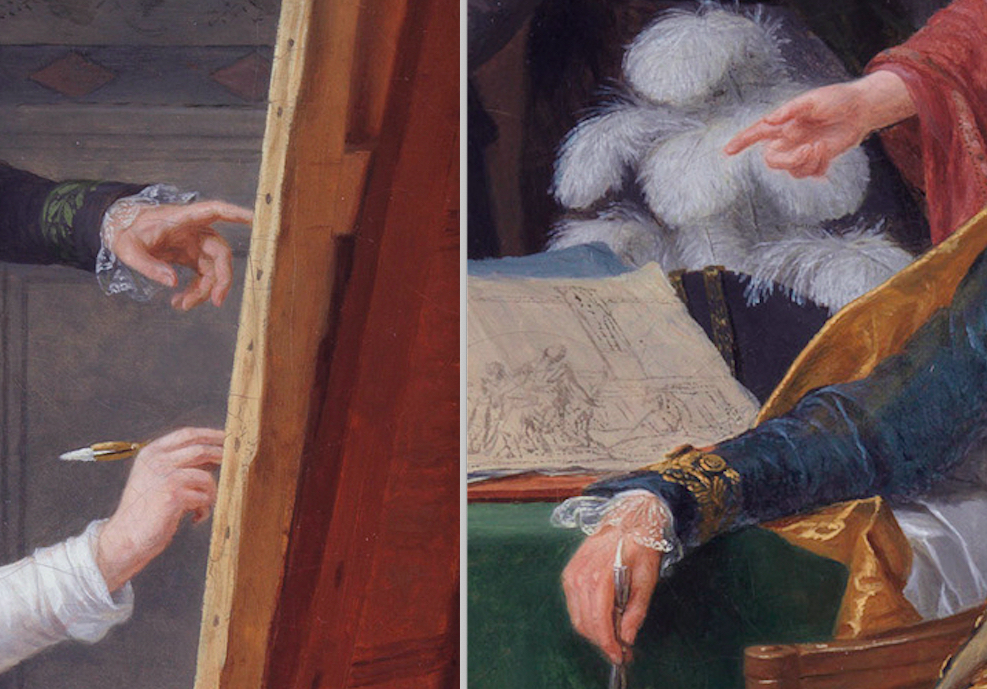
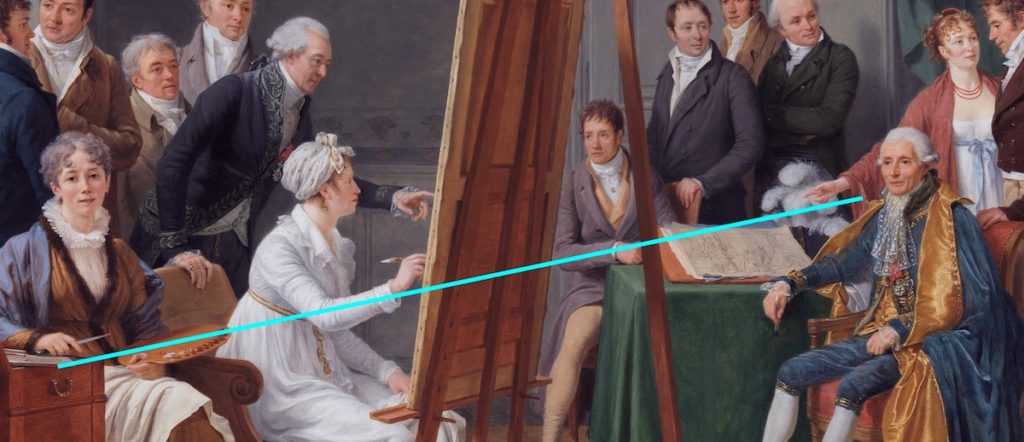
Pingback: Laboring Likeness: Charlotte Daniel Martner’s Paint Box in Martinique (1803-1821) – by Damiët Schneeweisz – Journal18: a journal of eighteenth-century art and culture